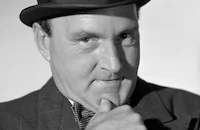The Mark

Brief Synopsis
Cast & Crew
Guy Green
Maria Schell
Stuart Whitman
Rod Steiger
Brenda De Banzie
Donald Houston
Film Details
Technical Specs

Synopsis
The only son of a domineering, pampering mother and a weak, ineffectual father, Canadian Jim Fuller grows into manhood doubting his masculinity. After an unhappy experience with a young woman his own age, he finds himself more and more attracted to younger girls until, finally, he abducts a 10-year-old. Though he does not assault the child, he is convicted for intent to molest the girl sexually and given 3 years in a British prison, during which time he undergoes group therapy supervised by the prison psychiatrist, Dr. McNally. Following his release from prison, Jim gets a job in a public relations firm owned by Mr. Clive, the only person, other than McNally, aware of Jim's alleged crime. Under the careful scrutiny of McNally, Jim begins his rehabilitation. Slowly his self-doubt begins to disappear, particularly when he is able to have a normal relationship with Ruth, an attractive widow and Mr. Clive's secretary. Another step forward in his readjustment is the healthy attitude he has toward Ruth's 11-year-old daughter, Janie. A child is assaulted by a man resembling Jim, but his alibi proves his innocence; shortly afterwards, however, an unscrupulous reporter, Austin, recognizes him at a carnival and publicly exposes his past. As a result, his landlady, Mrs. Cartwright, evicts him; he loses his job; and even Ruth rejects him, out of fear and panic, by refusing to let him touch Janie. Completely broken in spirit, he asks McNally to commit him to a mental institution. But through the kindly doctor's understanding and persistence, Jim decides to move to another town and make a fresh start. Ruth finds him there, apologizes for her past behavior, and begs him to give her the chance to make a new beginning.

Director

Guy Green
Cast

Maria Schell
Stuart Whitman

Rod Steiger
Brenda De Banzie
Donald Houston

Donald Wolfit
Paul Rogers

Maurice Denham
Amanda Black
Marie Devereux
Bill Foley
Anne Monaghan
Josephine Frayne

Eddie Byrne
Harry Baird
John Welsh
Russell Napier
Bandana Das Gupta
Crew
Richard Rodney Bennett
Michael Birkett
Sidney Buchman
Sidney Buchman
Roy Byrne
Bill Constable
Tony Cripps
Jimmy Devis
Eamonn Duffy
Christopher Farrell
John George
Norman Hargood
Stuart Hetherington
John Hollingsworth
Roy Hyde
Red Law
Josie Macavin
Pamela Mann
Stanley Mann
Charles Nash
Jack Rix
William Robinson
Maureen Roche
Liam Saurin
Ray Simm
Ann Skinner
Douglas Slocombe
Laurel Staffell
Raymond Stross
Raymond Stross
Peter Taylor
Chic Waterson
Leo Wilkins
Gilbert Wood
Jake Wright

Videos
Movie Clip



Hosted Intro
Film Details
Technical Specs

Award Nominations
Best Actor
Articles
The Mark
When we first meet Whitman's character, Jim Fuller, he's interviewing for a job that his psychiatrist, Dr. Edmund McNally, helped arrange for him. It's a good position, and the head of the business, Andrew Clive, is the only person there who knows what landed him behind bars. Clive's secretary, Ruth Leighton, knows that Jim served time but doesn't know what crime he was convicted of, and to all the others - including Roy Milne, a fellow employee nervous about competition - he's just a new worker hoping to succeed.
Jim settles smoothly into the office routine and finds a nice place to live, renting a room from an old couple nearby. He also makes regular visits to McNally, and we learn about his past through their conversations. We also see flashbacks to prior events, including the narrowly averted catastrophe that brought about his prison term. After failing in a love affair, strangely convinced that the woman's ordinary sexual desires made her a "nymphomaniac," he developed a crush on a little girl, abducting her in his car and driving to the countryside before growing sick with guilt and returning her to the city before anything worse happened. The girl's family and neighbors were in a panic over her disappearance, and Jim was immediately arrested.
Group therapy in the prison and sessions with McNally have now enabled Jim to control his impulses and develop normal relationships. Making a fresh start under a new name - he was Jim Fontaine in his previous life - he thrives in his job and gets romantically involved with Ruth, the secretary. He also becomes acquainted with a reporter named Austin, who recognizes him from when he was sent to jail. Austin seems sympathetic, but he has a hidden agenda. This sparks the story's climax when Jim takes Ruth's young daughter on an innocent excursion to a carnival, leading to awful complications.
Green decided to direct The Mark on the strength of the screenplay, adapted by Sidney Buchman and Stanley Mann from Charles Israel's novel, which Green never got around to reading. He felt the structure of the script was ideally suited to bringing out tension, suspense, and human drama, and he's right that the story follows a crisply ordered schedule. The first hint as to the nature of Jim's illness, when he becomes fixated on watching a girl in a playground, comes about a quarter of the way into the film; his wild ride with the abducted girl happens at the halfway mark; and the fateful carnival excursion takes place around three quarters of the way through. Green thought it was important to hold back the details of Jim's crime until the audience has time to develop sympathy for him as a character, and the strategy works just as he intended.
Commenting on The Mark years later, Green admitted that he shot it in CinemaScope only because it was a Twentieth Century Fox production and the studio loved exploiting its proprietary process. But his enthusiasm grew when he realized how the wide-screen format could enliven the many talk-heavy scenes by allowing multiple actors to share the frame, thus avoiding the need for constant cuts from one character to another. It also let him reserve close-ups for climactic moments when their impact can really hit home. Green also made canny use of McNally's coffee addiction to lend movement to the long dialogue scenes in the psychiatrist's office - every time things threaten to bog down, up pops Steiger to make, pour, or stir another couple of cups.
The performances in The Mark are excellent, especially considering that all three stars were last-minute substitutions in the cast. In addition to Whitman replacing Burton, the Austrian-born actress Maria Schell replaced British star Jean Simmons as Ruth, and Rod Steiger stepped in for Trevor Howard, who would probably have made McNally a proper and starchy physician instead of the spirited, good-humored counselor played by Steiger in the film's most invigorating scenes. Two actors from the Shakespearian stage, Donald Wolfit and Paul Rogers, play Clive and Milne, respectively, and Donald Houston is just smarmy enough as Austin the sneaky reporter. Maurice Denham and Brenda de Banzie (yet another last-minute addition) are exactly right as Jim's landlords.
It's a pleasure to find such first-rate acting in a movie by someone who started out not as a director but as a cinematographer. Green photographed his first picture in 1943 and soon embarked on a four-film collaboration with David Lean that included two classic Charles Dickens adaptations, Great Expectations (1946) and Oliver Twist (1948). He made the transition to director slowly, but by the middle 1950s he was turning out modestly budgeted crime dramas on a steady basis. He entered political waters in 1960 with The Angry Silence, a labor-union drama, and followed up with The Mark a year later. In one of his best-known achievements, he guided star Shelley Winters, first-time actress Elizabeth Hartman, and cinematographer Robert Burks to Oscars® for A Patch of Blue, a 1965 drama about the friendship of a young blind woman and an African-American man, which he both wrote and directed.
As cinematographer for some Walt Disney epics in the early 1950s, Green acquired a distaste for storyboards, feeling that rigid preplanning can stifle a director's creativity. Instead he covered his scripts with quick notes and sketches that could then be changed and adapted as ideas arose on the set. He also disliked too much rehearsal, which could take the spontaneity out of a scene; his method was to rehearse a sequence carefully just before the camera rolled, and he rarely needed more than three or four takes to get a shot the way he wanted it. The average for The Mark was about three takes per scene, except for the carnival episode, where Green shot a lot of footage and then worked closely with film editor Peter Taylor to assemble a lively, dynamic montage.
The Mark was made at a time when child-molestation cases were making headlines in England, and the film was criticized by some reviewers for being too bold - one accused it of taking a child abuser's side - and by others for not being bold enough, since Jim abducts but does not abuse a little girl, ultimately returning her to her family. Reviews aside, the picture did only moderate business at the box office in 1961, but its warmth, sincerity, and humanism make a strong impression to this day.
Director: Guy Green
Producer: Raymond Stross
Screenplay: Sidney Buchman and Stanley Mann; based on Charles Israel's novel
Cinematographer: Dudley Lovell
Film Editing: Peter Taylor
Production Designer: Ray Simm
Music: Richard Rodney Bennett
With: Maria Schell (Ruth Leighton), Stuart Whitman (Jim Fuller), Rod Steiger (Doctor McNally), Brenda de Banzie (Gertrude Cartwright), Donald Houston (Austin), Paul Rogers (Roy Milne), Donald Wolfit (Andrew Clive), Maurice Denham (Arnold Cartwright), Eddie Byrne (Acker), Amanda Black (Janie), Bandana Das Gupta (Inez), Harry Baird (Cole), Anna Monaghan (Mrs. Fontaine), Bill Foley (Mr. Fontaine), Marie Devereux (Ellen) Josephine Frayne (Patricia)
BW-127m.
by David Sterritt

The Mark
Mark, The - THE MARK, A LANDMARK DRAMA FROM 1961
While films and TV series that openly address the subject of child molestation and sex offenders are not that rare today, in 1961 it was practically a taboo topic. Few films had previously explored this problem on a serious level before The Mark, Fritz Lang's M (1931) being a rare exception. It was also unusual to find a film that treated its sexually conflicted protagonist with such compassion and honesty while at the same time revealing his darker, self-destructive side. In several scenes we see Fuller strugging with his inner demons, particularly in a sequence by a schoolyard playground where he observes some little girls playing and, most importantly, in a flashback where he comes close to molesting the little girl he adducted. Though Fuller never actually molests any prepubescent girls in The Mark (though he did in the novel), the threat is always there. Of course, it would have been a much more complex and challenging film if Fuller had actually been guilty of child molestation but in 1961 film censors would never have allowed such a film to be released. And moviegoers would most likely have boycotted it.
Viewed today, The Mark still stands as a thought-provoking and sensitive portrayal of a highly disturbed individual. It features one of Stuart Whitman's best performances and makes you wonder what he might have accomplished if he had been offered equally challenging roles in his career instead of being typecast as a rugged he-man in films like The Comancheros (1961) and Sands of the Kalahari (1965). Maria Schell is also excellent as the single mother with a young daughter who falls in love with him despite his past prison record. Admittedly, the film has a few flaws; the psychiatrist's Freudian analysis of Fuller's problems seems dated and rather simplistic and the prison flashback scenes are static and unconvincing, like an amateur stage play. Nevertheless, The Mark is an absorbing experience and garnered a Best Actor Oscar nomination for Whitman.
VCI Entertaiment has recently released a deluxe DVD version of The Mark, presented in the widescreen format with several extra features that should interest fans of this landmark drama. You have a choice of two separate commentaries, one with director Guy Green and one with Stuart Whitman, who discusses how he was cast in the film, his working relationship with Rod Steiger (in the role of the psychiatrist) and other insightful remarks. Green's commentary is more focused on technical aspects of the film and the sensitive nature of the material. The disc also includes the 2000 ASC Awards presentation by Karl Malden honoring director Guy Green along with the usual DVD trimmings: the theatrical trailer, behind-the-sceen photo gallery, film biographies and scene selection. For more information, visit VCI Entertainment.
By Jeff Stafford
Mark, The - THE MARK, A LANDMARK DRAMA FROM 1961
Guy Green (1913-2005)
He was born on November 5, 1913 in Somerset, England. Long fascinated by cinema, he became a film projectionist while still in his teens, and was a clapper boy by age 20. He bacame a camera operator during World War II in such fine war dramas as One of Our Aircraft Is Missing; In Which We Serve (both 1942) and This Happy Breed (1944). His big break came as a director of photography came for Carol Reed's The Way Ahead (1944). He was eventually chosen by David Lean to photograph Great Expectations (1946), and his moody, corrosive look at Dickensian London deservedly earned an Academy Award. His work as a cinematographer for the next few years were justly celebrated. Film after film: Blanche Fury (1947), Oliver Twist (1948), The Passionate Friends (1949), Captain Horatio Hornblower R.N. (1951), The Beggar's Opera (1953), I Am a Camera (1955), all highlighted his gift for cloud-soaked period pieces with sweeping vistas of broad landscapes.
He made his directorial debut in a modest crime drama, River Beat (1954). Some minor titles followed: Portrait of Alison (1955); House of Secrets (1956); the ingenious mystery thriller The Snorkel (1958); the controversial child molestation drama The Mark (1961) starring Stuart Whitman in an Oscar® nominated performance; and his breakthrough picture, The Angry Silence (1960) which starred Richard Attenborough as an outcast who tries to battle labor union corruption. This film earned Green a BAFTA (a British Oscar equivilant) nomination for Best Director and opened the door for him to Hollywood.
Once there, he proceeded to make some pleasant domestic dramas: Light in the Piazza (1962), and Diamond Head (1963), before moving onto what many critics consider his finest work: A Patch of Blue (1965). The film, based on Elizabeth Kata's novel about the interracial love between a blind girl (Elizabeth Hartman) and a black man (Sidney Poitier) despite the protests of her bigoted mother (Shelley Winters), was a critical and commercial hit, and it earned Green a Golden Globe nomination for Best Director.
Strangely, Green would never enjoy a critical success equal to A Patch of Blue again. Despite his talent for sensitive material and handling of actors, Green's next two films: a forgettable Hayley Mills vehicle Pretty Polly (1967); and The Magus simply didn't attract the moviegoers or the film reviewers. He redeemed himself slightly with the mature Anthony Quinn-Ingrid Bergman love story Walk in the Spring Rain (1970); and the historical drama Luther (1973), before he stooped to lurid dreck with Jacqueline Susan's Once Is Not Enough (1975).
Eventually, Green would find solace directing a series of television movies, the best of which was an adaptation of the Arthur Hailey (of Airport fame) novel Strong Medicine (1986) starring Sam Neill and Annette O’Toole. Green is survived by his wife Josephine.
by Michael T. Toole
Guy Green (1913-2005)
Quotes
Trivia
Notes
Location scenes filmed in Ireland. Opened in London in January 1961.

Miscellaneous Notes
Winner of the Samuel Goldwyn Award for Best British Film at the 1961 Golden Globes.
Released in United States Fall October 2, 1961
CinemaScope
Released in United States Fall October 2, 1961














